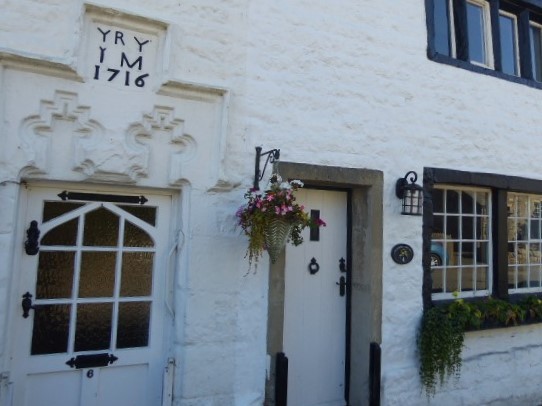I’ve walked quite a lot in the area around Bolton-By-Bowland, it is very special. I’m back here today with Clare and Zola to look at some of the highlights. It is too good to miss a day out in this September heat wave..
I have another of those Ribble Valley Walks of Taste to follow.
But we don’t follow it to the letter. For a start we leave the car in the little community car park by the bridge. I didn’t actually notice the Coach and Horses inn at all, so we fail to contribute to the Ribble Valley economy on this occasion.
Immediately by the bridge is a hidden well built into a wall, I can find no reference as to its provenance but it looks rather neat. 
We are soon into fields, guided by clear signs but all warning of your dog being shot if not on a lead, we don’t tell Zola. My reason for taking this different route is to see the mediaeval cross base marked on the map and Grade II listed. The stone is obvious in the first field under a spreading oak. We are not far from Sawley Abbey here and there must have been tracks through the countryside with crosses for guidance and perhaps prayer. 

There are a lot of beautiful mature trees to admire today in what was the estate of Bolton Hall. The original hall was built in 1229 and was set in a 2,000 acre estate. From the 14th century, the hall was in the hands of the Pudsay family until 1771. Henry VI hid here for a while after his defeat at the Battle of Hexham, he was later captured at Brungerly hipping stones over the Ribble. In another episode it is said that William Pudsay made a spectacular leap on horseback at nearby Ravensber Scar across the river to make his escape after being charged with counterfeiting silver shillings, the silver ore coming from mines on his estate near Rimington. The hall was demolished in 1958.
But we are not there yet. A bridge over the Skirden Beck means we don’t have to use the historic cobbled ford. 
We climb up the lane to reach the drive to Bolton Hall, but before following it I indulge in another ancient cross diversion. It is in a field with no obvious access so I make do with a zoom photo, it looks very similar to the last one.
Now down the drive, the hall has gone but outbuildings, stables and cottages have been renovated to provide modern exclusive accommodation. 
Of historical interest to us is King Henry’s well, where he may have hidden. It lies in the manicured grounds of the the Bolton Hall estate, but there is a gate for us to gain access for a photo at least. 
Some of the renovated cottages bear witness to their antiquity. 
Moving on we traverse a series of fields and a pheasant cover which drove Zola mad, being kept on a lead. We are high above the Ribble now where Sir Ralph Pudsey was said to have made his horseback leap. 
I have visited Fooden before and remember one of the house holders fitting a new weathervane, I wonder if it is still there. It is, though they have never got round to orientating the compass points. 
It turns out the man is a stone mason and he shows us some of his finished work. The sandstone he uses comes from Longridge Fell. Seeing our interest in the house opposite he tells us of another one down the lane. Both are C17th and Grade II listed. Just about everything is listed hereabouts. In fact the parish of Bolton-by-Bowland contains 44 listed buildings.

Pleasant fields bring us back into Bolton-by-Bowland where we make a beeline to the C15th Church of St. Peter and St. Paul. Inside, next to the Pudsay Chapel, is a remarkable memorial to Sir Ralph Pudsay who died in 1468. A limestone slab carved with figures of Sir Ralph, his 3 wives, and 25 children, together with their names. It is difficult to photograph, I have tried before.

The village is a delight of stone houses and cottages around a village green where there is another stone cross and the village stocks. Well worth a visit.




***














